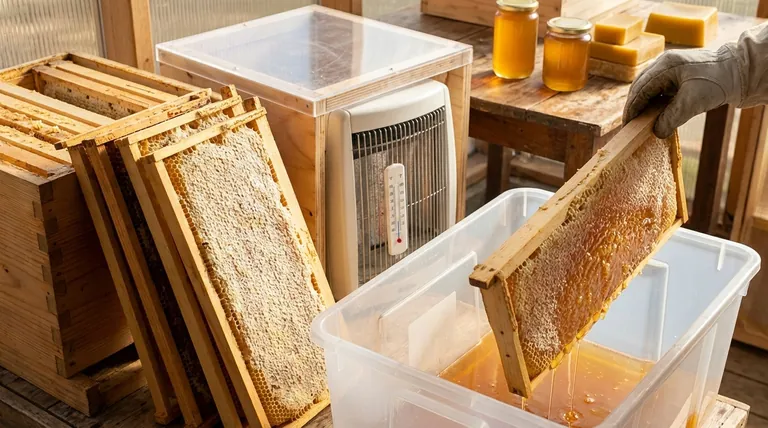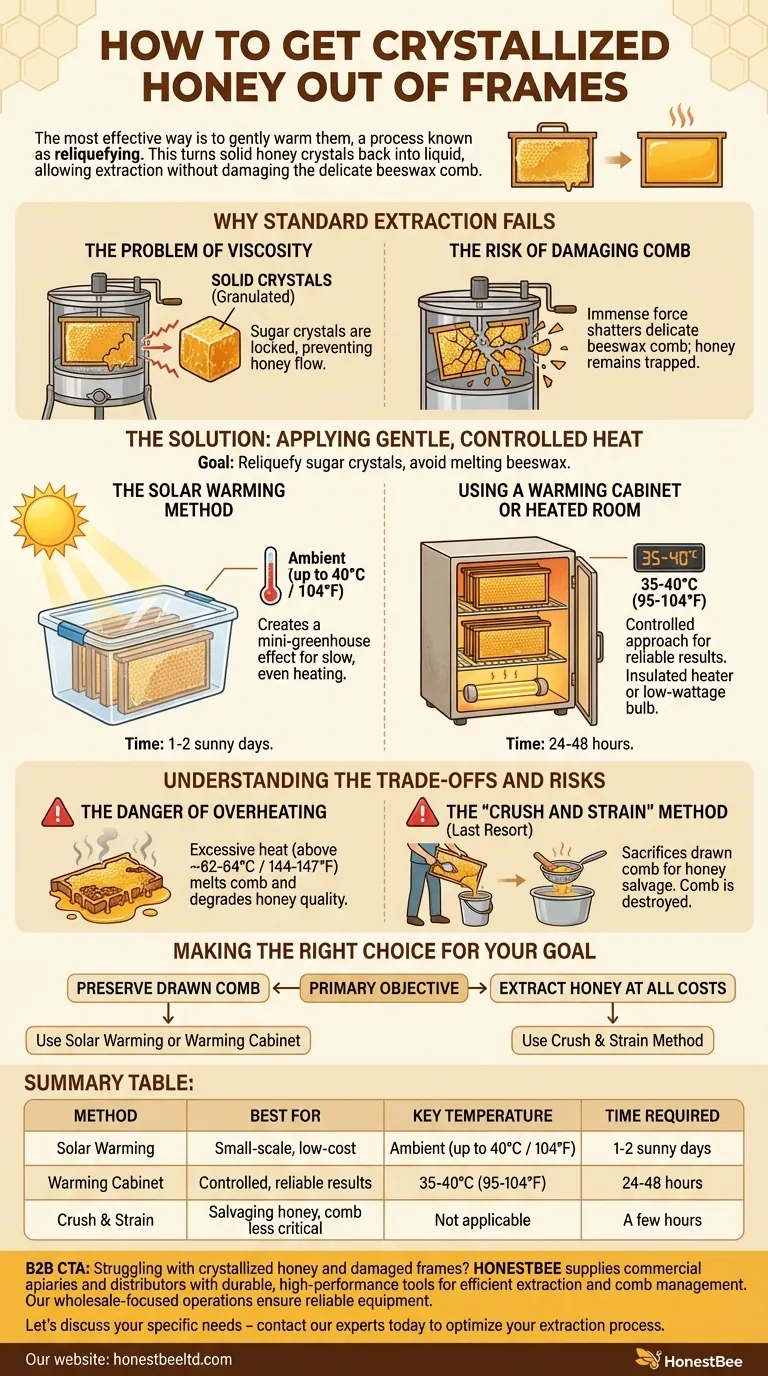The most effective way to get crystallized honey out of frames is to gently warm them. This process, known as reliquefying, turns the solid honey crystals back into a liquid state, allowing it to be extracted using standard methods or to simply drain from the comb. The key is to apply slow, controlled heat to avoid melting the beeswax and damaging the honey's quality.
Crystallization is a natural process in honey that can be reversed with gentle, controlled heat. The challenge is to liquefy the honey without melting the valuable beeswax comb, making the frame reusable for your bees.

Why Standard Extraction Fails with Crystallized Honey
The Problem of Viscosity
A centrifugal honey extractor works by spinning frames at high speed. This force slings the liquid honey out of the honeycomb cells.
Crystallized honey, also known as granulated honey or set honey, is essentially a solid. The sugar crystals are locked together, preventing the honey from flowing.
The Risk of Damaging Comb
Attempting to extract crystallized honey with a standard spinner will not work. The honey will remain in the cells, and the immense force can shatter and destroy the delicate beeswax comb, which takes a significant amount of energy for bees to build.
The Solution: Applying Gentle, Controlled Heat
The goal is to raise the honey's temperature enough to dissolve the sugar crystals but keep it below the melting point of beeswax, which is approximately 62-64°C (144-147°F).
The Solar Warming Method
A simple and effective method uses the sun. Place the frames inside a clear plastic tub or a custom-built solar warming box with a clear lid.
This creates a mini-greenhouse effect, slowly and evenly raising the internal temperature. As the honey softens, it will begin to flow and can be collected or extracted.
Using a Warming Cabinet or Heated Room
For a more controlled approach, use a warming cabinet or a small, insulated room with a gentle heater. An old refrigerator with a low-wattage light bulb can work well.
Aim for a consistent temperature between 35-40°C (95-104°F). This is warm enough to reliquefy the honey over 24-48 hours without any risk of melting the comb.
Understanding the Trade-offs and Risks
The Danger of Overheating
Applying too much heat too quickly is the biggest risk. This can melt the beeswax comb, creating a significant mess and destroying the valuable drawn-out comb.
Overheating also degrades the quality of the honey, destroying beneficial enzymes and altering its delicate flavor profile. Never use a high-powered oven or direct heat source.
The "Crush and Strain" Method: A Last Resort
If warming the frames is not feasible, the "crush and strain" method is another option. This involves scraping all the honey and comb off the frame into a bucket.
The mixture is then crushed and mashed to break up the cells, and the honey is separated by straining it through a sieve or filter.
The primary trade-off is that you sacrifice the drawn comb. The bees will have to expend significant resources to rebuild it, but you will successfully salvage the honey.
Making the Right Choice for Your Goal
Before you begin, decide what your primary objective is. Your goal will determine the best method.
- If your primary focus is preserving the drawn comb for reuse: Use a slow, gentle warming method like a solar warmer or a temperature-controlled cabinet.
- If your primary focus is extracting the honey at all costs: The crush and strain method is your most reliable fallback, but accept that the comb will be destroyed in the process.
Ultimately, dealing with crystallized honey is a manageable challenge that simply requires patience and the right application of gentle heat.
Summary Table:
| Method | Best For | Key Temperature | Time Required |
|---|---|---|---|
| Solar Warming | Small-scale, low-cost solution | Ambient (up to 40°C / 104°F) | 1-2 sunny days |
| Warming Cabinet | Controlled, reliable results | 35-40°C (95-104°F) | 24-48 hours |
| Crush & Strain | Salvaging honey when comb is less critical | Not applicable | A few hours |
Struggling with crystallized honey and damaged frames? HONESTBEE supplies commercial apiaries and beekeeping equipment distributors with the durable, high-performance tools needed for efficient honey extraction and comb management. Our wholesale-focused operations ensure you get the reliable equipment your business depends on. Let's discuss your specific needs – contact our experts today to optimize your extraction process.
Visual Guide

Related Products
- Plastic Hand Crank 2 Frame Honey Extractor Low Price
- 6 Frame Manual Stainless Steel Honey Extractor Beekeeping Equipment
- Stainless Steel 3 Frame Manual Honey Extractor Spinner for Bee Honey Extraction
- HONESTBEE 3-Frame Manual Acrylic Honey Extractor
- electric honey extractor honey centrifuge 3 frame honey extractor stainless steel honey frame extractor
People Also Ask
- What tips can maximize honey extraction efficiency? Unlock Higher Yields and Purer Honey
- What makes polyurethane foam environmentally friendly? The Surprising Benefits of a Durable, Inert Material
- Why are manual extractors popular among beginner beekeepers? A Guide to Starting Simple & Saving Money
- Can honey be harvested from frames with brood? The Critical Rule for Healthy Bees & Pure Honey
- What equipment is used for honey harvesting? Build Your Perfect Harvesting Toolkit



















